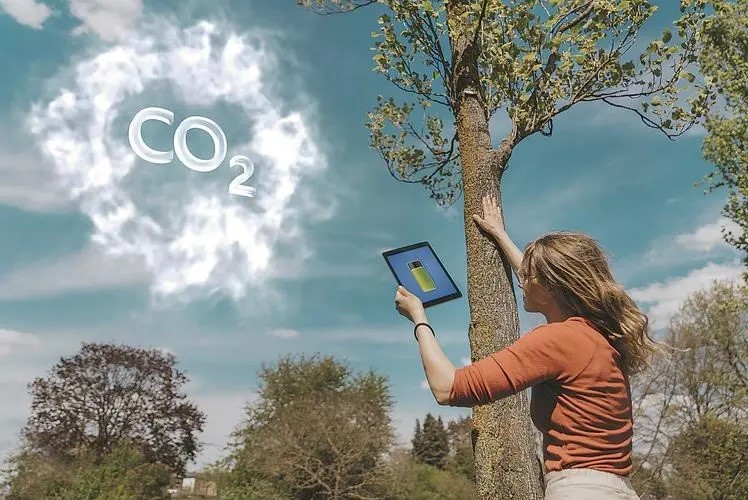In today's world, with the overuse of fossil fuels, the global climate change problem is becoming more and more serious. Against this backdrop, it is important to find clean and efficient energy solutions. As a new type of green energy storage technology, carbon dioxide battery (CO₂ battery) is gradually entering people's field of vision. From the perspective of semiconductor technology, China Exportsemi Web will popularize the science of carbon dioxide batteries to help readers and friends better understand this cutting-edge technology.
Introduction
Energy is the cornerstone of modern society, and battery technology is the key to energy storage. Although traditional lithium-ion batteries are widely used in portable electronic devices and electric vehicles, their energy density and environmental impact limit their further development. As an emerging battery technology, CO2 batteries can not only store and release electrical energy, but also convert carbon dioxide into useful compounds during discharge, realizing the dual functions of energy storage and carbon capture.
What is a CO2 battery?
CO2 batteries are a type of battery technology that uses carbon dioxide (CO₂) as the active material for the cathode. Unlike conventional batteries, it is not only able to store and release electrical energy, but also convert carbon dioxide into useful compounds such as carbonate and carbon during the discharge process, achieving the dual functions of energy storage and carbon capture.

Figure: What is a CO2 battery? (Image source: China Science Web)
How it works
The core reaction of a CO2 battery is the process by which carbon dioxide is reduced in the electrolyte. A typical CO2 battery contains two electrodes: an anode and a cathode. During battery operation, carbon dioxide molecules undergo a reduction reaction at the cathode, producing carbon and oxygen. At the same time, the anode undergoes an oxidation reaction to produce carbon dioxide and electricity.
The following diagram illustrates the basic working principle of a CO2 battery:

Figure: Basic working principle of CO2 batteries
Advantages of CO2 batteries
Environmental friendliness: CO2 batteries use CO2 as a raw material to help reduce the concentration of CO2 in the atmosphere, which is of great environmental significance.
Renewable energy: Unlike traditional fossil fuels, CO2 batteries can use renewable energy for electrolysis to produce carbon dioxide, forming a sustainable energy cycle system.
High energy efficiency: CO2 batteries have a high energy density and can store more energy in a smaller volume, making them suitable for a wide range of mobile devices and energy storage systems.
The development status of carbon dioxide batteries
Although CO2 battery technology has great application prospects, it is still in the research and development stage. Researchers are working to address the following challenges:
1. Slow electrochemical reaction kinetics: Due to the thermodynamic stability of CO2 and Li2CO3, the reaction speed during battery charging and discharging is slow.
2. High overpotential and low power density: This limits the battery's charge-discharge efficiency and fast response ability.
3. Limited cycle life: The performance of the battery decays after multiple charges and discharges, which affects the feasibility of long-term use.
Research progress and breakthroughs
A number of research institutions and companies around the world are actively exploring ways to address these challenges:
- Academician Cheng Huiming's team from Tsinghua University proposed an efficient bidirectional catalyst design that significantly improved the kinetics of CO2 reduction and precipitation reactions by constructing electrophilic and nucleophilic dual centers. This design not only improves the charging and discharging efficiency of the battery, but also helps to extend the life of the battery.
- Prof. Shujiang Ding and Prof. Yaqiong Su from Xi'an Jiaotong University have developed a novel manganese-based cathode catalyst to improve battery performance through in-situ electrochemical reconstruction. The electrochemical performance of the catalyst was significantly improved by optimizing the electronic structure and coordination environment of the catalyst.
- Peng Tan's team from the University of Science and Technology of China (USTC) has provided a new regulatory strategy for the development of lithium carbon dioxide batteries by studying the effect of multi-component collaborative transport on lithium-carbon dioxide batteries. Their research shows that the overall performance of the battery can be significantly improved by optimizing the positive and negative electrode materials, electrolytes, etc. of the battery.
Application prospects of carbon dioxide batteries
The applications of carbon dioxide batteries are promising, including but not limited to:
1. Large-scale energy storage systems: Provide efficient energy storage solutions for renewable energy sources such as wind and solar. With the rapid development of renewable energy, how to efficiently store and utilize these energy sources has become an important issue. CO2 batteries, with their high energy density and carbon capture capabilities, are expected to be a key technology to solve this problem.
2. Electric Vehicles: Offer longer range and faster charging speeds. The proliferation of electric vehicles requires more efficient and environmentally friendly battery technology. Carbon dioxide batteries can not only provide higher energy density, but also reduce carbon emissions to a certain extent, which is in line with the environmental protection needs of electric vehicles.
3. Environmental remediation: Help reduce greenhouse gas emissions as part of carbon capture technologies. CO2 batteries convert carbon dioxide into useful compounds during discharge, helping to reduce the amount of carbon dioxide in the atmosphere and combat global warming.
4. Deep space exploration: In the exploration of planets such as Mars, the abundant local CO2 resources are used for energy supply. About 95% of the Martian atmosphere is CO2, and CO2 batteries can use these resources to power the probe while reducing dependence on Earth's resources.
Epilogue
As an innovative energy technology, carbon dioxide batteries are not only expected to change the way we store energy, but also provide new ideas for combating climate change. With the continuous progress and optimization of technology, we have reason to believe that carbon dioxide batteries will play an important role in the future energy field and become a key force to promote the development of green energy.






